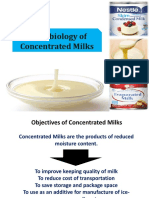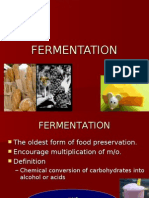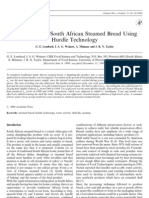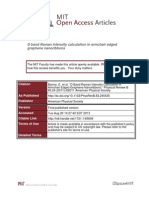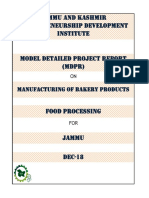56 Preventing Rope Spoilage PDF
56 Preventing Rope Spoilage PDF
Uploaded by
Mkt SchrbrCopyright:
Available Formats
56 Preventing Rope Spoilage PDF
56 Preventing Rope Spoilage PDF
Uploaded by
Mkt SchrbrOriginal Title
Copyright
Available Formats
Share this document
Did you find this document useful?
Is this content inappropriate?
Copyright:
Available Formats
56 Preventing Rope Spoilage PDF
56 Preventing Rope Spoilage PDF
Uploaded by
Mkt SchrbrCopyright:
Available Formats
56 MICROBIOLOGY
Preventing rope spoilage
ROPINESS - FEARED FOR CENTURIES BUT SO FAR NO REMEDY HAS BEEN FOUND. SPECIAL
AT TE NT ION M U ST B E PAI D I N COU NTR I E S W H E R E SOU R DOUG H B R E ADS AR E NOT T YPIC AL
AND WHERE THE STORAGE CONDITIONS FOR BREAD ARE ALMOST IDEAL FOR ROPE FORMERS
++ figure 1
Rope spoilage is a condition of bacterial decomposi- strain that prevails under the given conditions to trigger the
+ tion of the bread crumb. Spoilage organisms are dif-
ferent Bacillus species whose heat-resistant spores survive
spoilage. Therefore, the determination of the total count
does not make sense. Since the spores are activated when
the baking process. Most important rope formers are Bacil- coming into contact with water at higher temperatures, the
lus subtilis, B. licheniformis and B. pumilus. Ropiness is only use of hot soaker dough should be considered with care. Hot
visible for a short period of time; some strains do not even soaker doughs should be cooled down and processed as
form ropes at all. The main characterization is therefore a quickly as possible. Acidification of bread made with hot
fruity, melon-type odor. Discoloration of the crumb and a soaker dough is recommended.
bitter taste may also be other symptoms. The bread disease Care should also be taken when using waste bread. An al-
occurs in non-acidified wheat breads but can also be experi- ready activated Bacillus can be reintroduced into the bread
enced in slightly acidified groat bread or fine bakery ware. via waste bread. The disease can multiply in this way. When
Packed wheat bread with a long shelf life such as toast bread using waste bread, acidification is also recommended. Fur-
is highly susceptible. According to Dr. Markus Brandt, Man- thermore, storage containers for waste bread must be
ager Research, Development and Quality at Ernst Böcker cleaned frequently and thoroughly. The same is applicable
GmbH, Minden, Germany; the bread disease will occur in for the use of waste bread slurry. The containers should be
non-acidified bread at least 14 days after storage at 35°C. cleaned at least once a week and subsequently disinfected.
It is recommended that the slurry is stored at temperatures
Prevention below 25°C.
A comprehensive project on the subject of ropiness and rope
formers is running currently under the aegis of Prof. Dr.
Corinne Gantenbein-Demarchi at the Institute for Food and Optimum growth conditions
Beverage Innovations ILGI, Wädenswil, Switzerland. One for rope formers
part of the project is the development of a rapid method for + 35-45°C
identification of the rope formers. According to Brandt, the + Humid environment (e.g. packed bread)
microbiological counts in flour do not indicate the presence + pH >5.3 +++
of rope forming bacteria. It needs only one spore from a
BAKING+BISCUIT ISSUE 04 2008
MICROBIOLOGY 57
Bread with a long shelf life should be acidified for food safe-
ty reasons. The bread crumb should have a pH of below 5.2. Prevention of rope
A low pH can be achieved effectively with a strong acid. Lac- Hot soaker dough Sourdough Waste bread
tic acid is therefore preferred over acetic acid. The use of so- cool quickly, Wheat cool slurry, clean storage
short storage time sourdough containers frequently,
dium diacetate is therefore not very efficient. When using for light in warm countries
sourdough, it must be considered that the lactic acid forma- baked goods avoid the use of slurry
tion in a wheat sourdough is better than in a rye sourdough. and lots of and process waste
lactic acid bread into dry bread
According to Brandt, the reason for this is the composition of crumbs (breading)
sugars in the grain. Lactic acid bacteria which do not only
produce lactic acid but also acetic acid need fructose for the
formation of acetic acid. Wheat contains less fructose than
rye so that the lactic acid formation in wheat sourdough
Dough
dominates. Citric acid is hardly efficient as protection
against ropiness because citric acid is a rather weak acid. Af-
ter baking, the breads should be allowed to cool down as
quickly as possible. The storage temperature should not ex- Proofing
ceed 30°C.
For control purposes, risk products should be stored at
37°C for several days and then checked for rope forming
Baking
bacteria.
short baking times promotes rope
When selecting cleaning agents, it is important that no bac-
teriological agent is used. There are cleaning agents com-
mercially available that contain Bacillus species to support
Cooling
the degradation of food residues during cleaning. cooling period as short as possible
Measures to be taken if ropiness has been found
If ropiness has been determined in bread, the sourdough Storage
proportion in production should be increased for safety rea- below 30°C
sons. If needed, an additional acidification with lactic acid is
possible. Since some Bacillus strains form toxins, the entire ++ figure 1
batch – as far as it can be identified – should be recalled. Bread with ropiness
When using waste bread or slurry, discard all supplies and ++ figure 2
clean all storage containers thoroughly. +++ Decomposition of the bread crumb
++ figure 2
Photos: Zurich University of Applied Sciences, Inst. of Food and Beverage Innovation, Prof. Dr. Corinne Gantenbein-Demarchi
BAKING+BISCUIT ISSUE 04 2008
You might also like
- River Road RecipesDocument261 pagesRiver Road Recipescyberblah100% (4)
- A Methodological Critique of Bandura's Self-Efficacy Theory of Behavior Change.Document2 pagesA Methodological Critique of Bandura's Self-Efficacy Theory of Behavior Change.Mkt SchrbrNo ratings yet
- Cook's Illustrated - August 2016Document36 pagesCook's Illustrated - August 2016Senia Dzwoneczek Žarković100% (1)
- Preventing Rope SpoilageDocument2 pagesPreventing Rope SpoilageNhật Nguyễn SĩNo ratings yet
- Microbiology of Condensed and Evaporated MilkDocument22 pagesMicrobiology of Condensed and Evaporated MilkMantee KumariNo ratings yet
- Preservation of Milk and Milk Products From Microbial SpoilageDocument13 pagesPreservation of Milk and Milk Products From Microbial SpoilageShatumbu WilbardNo ratings yet
- Sourdough TechnologyDocument7 pagesSourdough TechnologySQF PractitionerNo ratings yet
- Mbio313 Assignment 01 181-025-031Document7 pagesMbio313 Assignment 01 181-025-031Razia UrmiNo ratings yet
- Contamination, Preservation, andDocument21 pagesContamination, Preservation, andVaibhav UpadhyayNo ratings yet
- FermentationDocument38 pagesFermentationpost harvest technology70% (10)
- Nissin Danisco UkDocument3 pagesNissin Danisco UkRafita De la HuertaNo ratings yet
- 2.uploads Downloads DOWN 71F3002C199B073ABrygram2 BiscuitDocument1 page2.uploads Downloads DOWN 71F3002C199B073ABrygram2 BiscuitPhanhai KakaNo ratings yet
- MCB180 EX13 Full ReportDocument3 pagesMCB180 EX13 Full ReportMyles ResumaNo ratings yet
- Production of Cheese by Eric BioDocument15 pagesProduction of Cheese by Eric BioNkosinathiNo ratings yet
- Quality MaitenanceDocument2 pagesQuality Maitenanceohnestman4uNo ratings yet
- Food TechnologyDocument26 pagesFood TechnologySanjayMeeraNo ratings yet
- CH - 01 - Historical Background of Biotech - 071808Document4 pagesCH - 01 - Historical Background of Biotech - 071808hatunhalime82No ratings yet
- The Processing of MilkDocument4 pagesThe Processing of MilkRahulNo ratings yet
- Biotechnology CompleteDocument25 pagesBiotechnology CompleteMuhammad Usman Khalid AminNo ratings yet
- Dairy Products NotesDocument65 pagesDairy Products NotesAbhishek GawaliNo ratings yet
- FermentationDocument38 pagesFermentationhiteshtanwer13No ratings yet
- Method of Preservation of Starter CultureDocument10 pagesMethod of Preservation of Starter CultureLegend GamerNo ratings yet
- 06 Handout 1Document2 pages06 Handout 1Daisylyn ArellanoNo ratings yet
- OOD Echnology: Micro-Organisms in Food ProductionDocument19 pagesOOD Echnology: Micro-Organisms in Food ProductionlelascepanovicNo ratings yet
- Envasado de PanDocument12 pagesEnvasado de PanJuan Luis Mejias GarciaNo ratings yet
- Food Technology and EngineeringDocument9 pagesFood Technology and EngineeringFreefire IdNo ratings yet
- Chemistry ProjectDocument15 pagesChemistry ProjectSahil GuptaNo ratings yet
- Brandt 2007Document4 pagesBrandt 2007PejeRodroNo ratings yet
- CheeseDocument30 pagesCheeseAdams SadikNo ratings yet
- Contamination, Preservation & Spoilage of Milk and Milk ProductsDocument55 pagesContamination, Preservation & Spoilage of Milk and Milk ProductsNur AzizaNo ratings yet
- PBL FermentasiDocument13 pagesPBL FermentasisyafiahNo ratings yet
- UNIT II - Basic BakingDocument33 pagesUNIT II - Basic Bakingyf6xy8b2jpNo ratings yet
- Methods of Food PreservationDocument42 pagesMethods of Food PreservationSimone Jean MarieNo ratings yet
- Article 26Document9 pagesArticle 26palsantanu8837276365No ratings yet
- Nissin Danisco UkDocument3 pagesNissin Danisco UkNourane KhaledNo ratings yet
- Food SpoilageDocument13 pagesFood SpoilageKrithishNo ratings yet
- Microbiology of Milk and It's ContaminantsDocument26 pagesMicrobiology of Milk and It's ContaminantsKavin ANo ratings yet
- 3.FinalRecentTechnologiesinDairysci Finalbook 17 5 20192 67 94Document29 pages3.FinalRecentTechnologiesinDairysci Finalbook 17 5 20192 67 94sudhineeharindhanavudhiNo ratings yet
- Group 3: Preparation of Soyabean Milk and Its Comparison With Natural MilkDocument13 pagesGroup 3: Preparation of Soyabean Milk and Its Comparison With Natural Milkviraj muzumdarNo ratings yet
- Bakery Technology - Yeast and Sourdough.3 PDFDocument22 pagesBakery Technology - Yeast and Sourdough.3 PDFabs microNo ratings yet
- Ilide - Info Biology Project PRDocument49 pagesIlide - Info Biology Project PRKeshav Singh ThakurNo ratings yet
- HB Yr 11 Pp1 RevisionDocument8 pagesHB Yr 11 Pp1 RevisionAynah AbdiNo ratings yet
- 2024 Module 1 Microbes in Household ProductsDocument4 pages2024 Module 1 Microbes in Household ProductsKhadeeja RushinNo ratings yet
- Script Yeast Fermentation and Its Products The Topic Yeast Fermentation and Its Products Will Be Discussed Under 5 Sub Units Such AsDocument6 pagesScript Yeast Fermentation and Its Products The Topic Yeast Fermentation and Its Products Will Be Discussed Under 5 Sub Units Such Asankitapramanik74No ratings yet
- Psychedelic EucharistDocument9 pagesPsychedelic Eucharistjose luis fernandezNo ratings yet
- Unit 15 PDFDocument11 pagesUnit 15 PDFRiddhi KatheNo ratings yet
- Production of CheeseDocument26 pagesProduction of CheeseMahathir Mohmed100% (4)
- Food Fermentation GROUP 4Document27 pagesFood Fermentation GROUP 4Devashish NarayanNo ratings yet
- Wort SouringDocument19 pagesWort Souringgaffodio hadrienNo ratings yet
- Principles of Milk ChillingDocument14 pagesPrinciples of Milk Chillingsangkips750No ratings yet
- Food Processing and Preservation - SampleDocument14 pagesFood Processing and Preservation - Samplestatus loverNo ratings yet
- Anand 87-2020 Preservation of Milk and Milk ProductsDocument21 pagesAnand 87-2020 Preservation of Milk and Milk Productsvrushalipatil2517No ratings yet
- Cheese Manufacturing ProcessDocument8 pagesCheese Manufacturing ProcessBenzene100% (1)
- Production of Baker's YeastDocument11 pagesProduction of Baker's YeastrexamomosNo ratings yet
- Bread Lecture CPTDocument6 pagesBread Lecture CPTJessie Mae AntonioNo ratings yet
- Robsaan KootiDocument8 pagesRobsaan KootiDhugaan GalgalaafNo ratings yet
- Artisan Bread Flour Quality & FormulationDocument8 pagesArtisan Bread Flour Quality & FormulationAshif MahmudNo ratings yet
- StalingBAKERpaper 2022Document7 pagesStalingBAKERpaper 2022SQF PractitionerNo ratings yet
- Hurdle Technology For BreadDocument6 pagesHurdle Technology For BreadNamratha KolluNo ratings yet
- CHUCRUTDocument25 pagesCHUCRUTIllescas Coimbra Romy HelgaNo ratings yet
- Cibia 9 - Congreso Iberoamericano de Ingeniería de Alimentos - Libro de Actas - 4Document2 pagesCibia 9 - Congreso Iberoamericano de Ingeniería de Alimentos - Libro de Actas - 4Edwin Chila ChoqueNo ratings yet
- Sourdough Mastery: A Comprehensive Guide to Perfecting the Art of Bread MakingFrom EverandSourdough Mastery: A Comprehensive Guide to Perfecting the Art of Bread MakingNo ratings yet
- Artisan Sourdough: Wholesome Recipes, Organic GrainsFrom EverandArtisan Sourdough: Wholesome Recipes, Organic GrainsRating: 3 out of 5 stars3/5 (1)
- DiffInt PDFDocument2 pagesDiffInt PDFMkt SchrbrNo ratings yet
- Achievement Motivation - Conceptions of Ability, Subjective Experience, Task Choice, and Performance.Document19 pagesAchievement Motivation - Conceptions of Ability, Subjective Experience, Task Choice, and Performance.Mkt SchrbrNo ratings yet
- Awakening MonsterDocument128 pagesAwakening MonsterMkt SchrbrNo ratings yet
- Theoretical Weaknesses Lead To Practical Problems - The Example of Self-Efficacy TheoryDocument9 pagesTheoretical Weaknesses Lead To Practical Problems - The Example of Self-Efficacy TheoryMkt SchrbrNo ratings yet
- PHZ6426: Fall 2013 Problem Set # 6: Electron Transport. Phonons. Due Monday, 12/02 at The Time of The Class Instructor: D. L. Maslov Maslov@phys - Ufl.edu 392-0513 Rm. 2114 Office Hours: TR 3 pm-4 PMDocument9 pagesPHZ6426: Fall 2013 Problem Set # 6: Electron Transport. Phonons. Due Monday, 12/02 at The Time of The Class Instructor: D. L. Maslov Maslov@phys - Ufl.edu 392-0513 Rm. 2114 Office Hours: TR 3 pm-4 PMMkt SchrbrNo ratings yet
- Ex 2Document2 pagesEx 2Mkt SchrbrNo ratings yet
- Full Text 01Document8 pagesFull Text 01Mkt SchrbrNo ratings yet
- Notes SpindfsDocument22 pagesNotes SpindfsMkt SchrbrNo ratings yet
- OweekDocument1 pageOweekMkt SchrbrNo ratings yet
- D Band Raman Intensity Calculation in Armchair Edged Graphene NanoribbonsDocument9 pagesD Band Raman Intensity Calculation in Armchair Edged Graphene NanoribbonsMkt SchrbrNo ratings yet
- Lotus Vegetarian Restaurant Menu PDFDocument2 pagesLotus Vegetarian Restaurant Menu PDFsamba8000No ratings yet
- Tomato SalsaDocument5 pagesTomato Salsarobz OcampoNo ratings yet
- j1188 Fiji1 Khana Kakana CookbookDocument48 pagesj1188 Fiji1 Khana Kakana Cookbookapi-295418392100% (2)
- Fun Fair Report - Tauseef SharifDocument4 pagesFun Fair Report - Tauseef SharifReXX GamingNo ratings yet
- Carl Group ProposalDocument4 pagesCarl Group ProposalStella RicafrenteNo ratings yet
- Katalog Cedea 2018Document2 pagesKatalog Cedea 2018fenny talimNo ratings yet
- SoupDocument15 pagesSoupAngel ThioNo ratings yet
- North Freo Fresh Lunch MenuDocument1 pageNorth Freo Fresh Lunch MenuNorth Fremantle Primary SchoolNo ratings yet
- Jammu and Kashmir Entrepreneurship Development Institute: Manufacturing of Bakery ProductsDocument36 pagesJammu and Kashmir Entrepreneurship Development Institute: Manufacturing of Bakery Productsbhushan chavankeNo ratings yet
- 19123rm New Tick Sheet Menu Design STD Digital LRDocument1 page19123rm New Tick Sheet Menu Design STD Digital LROakgona KgoniNo ratings yet
- Indian Vegetarian Foods To Gain WeightDocument14 pagesIndian Vegetarian Foods To Gain WeightSabari NathanNo ratings yet
- Telangana WriteupDocument1 pageTelangana WriteupSriramSachinGudimellaNo ratings yet
- Spices in MeghalayaDocument10 pagesSpices in MeghalayaBandita Bagchi0% (1)
- Alc Book15Document85 pagesAlc Book15Roberto K-Brown CarlosNo ratings yet
- Jamie Oliver Cook Book - Tense Exercises in RecipesDocument3 pagesJamie Oliver Cook Book - Tense Exercises in RecipesNele KrivokapićNo ratings yet
- Crown Perth Restaurants Bistro Guillaume Main MenuDocument1 pageCrown Perth Restaurants Bistro Guillaume Main MenuBenoit NouguierNo ratings yet
- Icelandic Fish & Chips MenuDocument2 pagesIcelandic Fish & Chips MenuNell CaseyNo ratings yet
- Food and RestaurantDocument3 pagesFood and RestaurantAna María PulgarínNo ratings yet
- Jollibee - WikipediaDocument34 pagesJollibee - WikipediaMera FerrerNo ratings yet
- Guide To ProofingDocument24 pagesGuide To ProofingLouanneNo ratings yet
- Story: Alexander Darren Everest Ang Dominican AspirantDocument5 pagesStory: Alexander Darren Everest Ang Dominican AspirantAlexander DarrenNo ratings yet
- Dinner Menu: Salads and AppetizersDocument4 pagesDinner Menu: Salads and Appetizerssupport_local_flavorNo ratings yet
- Fill in The Blanks With Correct WordsDocument8 pagesFill in The Blanks With Correct WordsGopalakrishnan KuppuswamyNo ratings yet
- French CuisineDocument70 pagesFrench CuisineTrevor James EmpleoNo ratings yet
- October 13, 2019 - 28Th Sunday in Ordinary Time: Mass Schedule Welcome!Document6 pagesOctober 13, 2019 - 28Th Sunday in Ordinary Time: Mass Schedule Welcome!api-462192637No ratings yet
- MH Distributor & Stockiest Price List (Elite Div)Document5 pagesMH Distributor & Stockiest Price List (Elite Div)S I DesaiNo ratings yet
- ApplePieBouchee EnocDocument4 pagesApplePieBouchee EnocDAlejanNo ratings yet
- Descriptive ProductUas InggrisDocument3 pagesDescriptive ProductUas InggrisMuchammad Miftakul UlumNo ratings yet




